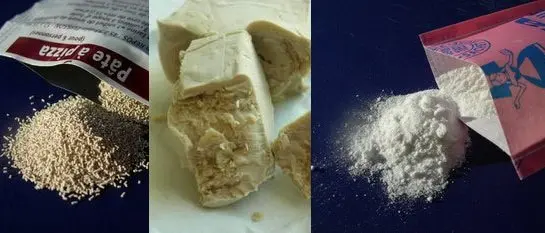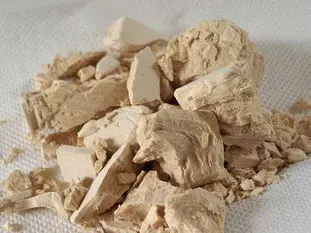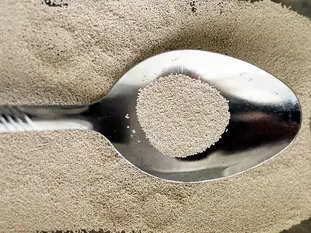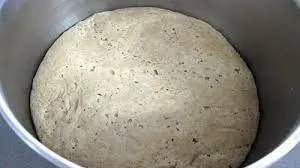The blog of cooking-ez.com
Raising (or leavening) agents

When we want to make a dough or batter rise when baking, either in patisserie or bread-making, we need to use a raising agent or leavening agent, one of which is called leaven.
In the context of baking, a raising agent is simply what "makes something rise". It is a substance which, when added to the dough or batter makes it swell up by creating thousands of tiny bubbles of carbon dioxide within it.
As there are 2 kinds of yeast, 2 kinds of leaven and baking powder as well, this can be confusing, so here is a summary of the different types and how they act.
In the context of baking, a raising agent is simply what "makes something rise". It is a substance which, when added to the dough or batter makes it swell up by creating thousands of tiny bubbles of carbon dioxide within it.
As there are 2 kinds of yeast, 2 kinds of leaven and baking powder as well, this can be confusing, so here is a summary of the different types and how they act.
51K 18 4.8
Last modified on: June 16th 2021
Raising (or leavening) agents
Baker's Yeast
This is the yeast used by bakers to make bread, brioches, etc. It is basically the same kind that brewers use to make beer, so it is sometimes also known as brewer's yeast.Yeast is a living organism, a microscopic fungus, called saccaromycès cerevisae, which reacts with the sugars in flour to form carbon dioxide. It is this fermentation process that makes the dough rise. Yeast is available in 2 forms:
Fresh yeast

Dried yeast

Baking powder

Baking powder is used mostly for cakes, scones, etc.
Leaven
Leaven is a natural raising agent, like yeast. It is made from a mixture of water and flour that begins to ferment when exposed to the naturel yeasts present in the air.
It is a living substance and reacts with the sugars in flour to form carbon dioxide by fermentation, which makes the dough rise. Two different forms can be made:
Liquid leaven

Stiff leaven

Whether the leaven is liquid or stiff it makes little difference in its use, but a lot in the taste of the bread obtained.
It is worth noting in passing that when making leavened bread, it is usual to combine a large amount of leaven with a little yeast. This improves the bread's appearance especially the crust.
Summary
We can say that yeast and leaven work by fermentation, whereas baking powder uses a chemical reaction.
Lasts posts
Wipe meats and fish before cooking
When you want to cook meat or fish, there's a very simple yet very important step to take before you even start: It's to dry, or wipe, each side of the meat or fish, sometimes called "dabbing" or "sponging". But why? And how? Let me explain.4915 April 14th 2024
Toss the salad
When you've finished preparing a salad, green or otherwise, it's usually time to add the dressing and toss. It's often said to "toss the salad", which means to season and mix. Is it easy? Not so easy...2,2805 March 8th 2024
Half milk, half cream
In a multitude of recipes, savoury or sweet, milk is used as the main ingredient, or at least as the main liquid ingredient. Milk is used instead of water, for example, because milk contains a proportion of fat, which adds roundness and softness to the recipe. This mellowness is very pleasant on...2,225 February 27th 2024
Cutting soft cheeses
As you may have already noticed, when you have to use a "soft" cheese in a recipe - their exact name is "soft cheese" - such as Camembert, Munster or Mont d'or, it's not easy to make anything other than thick slices.2,3725 February 20th 2024
It's spinning too fast!
When you need to grate or slice vegetables, you generally use an electric machine that does all the work: a food processor, a mixer with a "slicer" extension or similar. Are these machines really suitable? Generally speaking, yes of course, but there's one criterion that often poses a problem,...5,2595 November 12th 2023
Other pages you may also like
The golden-brown finish on puff pastry
Let's take a look at the tricky matter of producing puff pastry with an attractive, golden-brown finish. French pastry chefs call this "dorure" (literally, "gilding"). Behind this quirky term there lurks a real problem (and the solution): when using puff pastry (pâte feuilletée) for a pie, or...39K 24.7 February 8th 2018
For well opened (puffed) cakes
It's always nice to have a well puffed up cake after baking, not only will it taste good but it looks great too. Let's see how to get this beautiful shape almost every time.26K4.2 January 23th 2019
The baker always gild twice
I've already told you about gilding, the beaten whole egg that is spread with a brush on anything that needs to brown in the oven: puff pastry, pastries, etc. and that professionals use a lot, I'm going to come back to this to clarify a bit how to do it, and give you a professional tip.26K4.2 June 9th 2019
The skin of the almonds
If you like almonds, in their dried fruit version, you must use them quite often in cooking or baking, whether powdered or whole. It is not obvious, but in fact there is 2 kinds of almonds in the market, wholesale with or without the skin. .18K4.7 February 8th 2020
The right weight of pastry for a pie
Let's try to solve a thorny problem: How much dough will I need when I make my next pie? You're planning to make a pie, you're going to use your favourite mould or circle, but how much pastry will you need to fill it completely with a well spread pastry, without being too thin, or on the contrary...58K4.3 March 20th 2020
Follow this page
If you are interested in this page, you can "follow" it, by entering your email address here. You will then receive a notification immediately each time the page is modified or a new comment is added. Please note that you will need to confirm this following.
Note: We'll never share your e-mail address with anyone else.
Alternatively: you can subscribe to the mailing list of cooling-ez.com , you will receive a e-mail for each new recipe published on the site.









